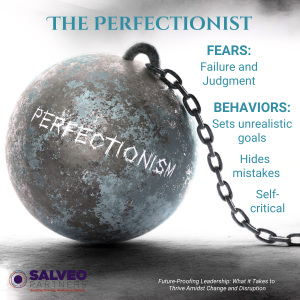In our research of 250 leaders across industries, nearly one in three showed patterns consistent with the Perfectionist Faulty Program — one of the most quietly exhausting operating systems leaders run.
Perfectionism is often mistaken for a strength. We applaud leaders who hold themselves and their teams to high standards—those who “never settle” and “sweat the details.” But there’s a fine line between healthy striving for excellence and the perfectionistic pattern that keeps leaders trapped in the Stuckness Zone™.
We found that nearly 30% are running the Perfectionist Faulty Program—a pattern fueled not by a love of quality, but by a fear of judgment and failure. On the surface, these leaders appear polished, reliable, and meticulous. Beneath the surface, however, they’re often exhausted, anxious, and secretly afraid that one misstep could unravel their credibility.
This article is part of our Faulty Programs series. If you’re new here, start with our opener—“Why Leaders Get Stuck: The Stuckness Zone™ and Faulty Programs.” It lays the groundwork for what Faulty Programs are, how they form, and why upgrading them is essential for future-ready leadership.
How the Perfectionist Program Shows Up
The Perfectionist program reveals a deep-seated need to get things “just right.” It’s driven by the belief that mistakes are dangerous and that worthiness, belonging, or respect are tied to flawless performance.
Leaders running this program often:
- Set unrealistic expectations—for themselves and sometimes for others.
- Over-prepare, overwork, and over-correct.
- Delay decisions or feedback, waiting for the “perfect” version.
- Struggle to delegate because “no one can do it right.”
- Hide mistakes and are critical of themselves.
Over time, this pattern creates stress, erodes confidence, and hinders innovation. The irony? In trying so hard not to fail, perfectionists often slow progress or unintentionally create the very tension they fear.

The Fears Driving the Perfectionist
At its core, the Perfectionist is rooted in fear of failure and judgment. Somewhere along the way, leaders with this program learned that making mistakes led to rejection, disapproval, or loss of connection. The unspoken belief becomes:
“If I’m perfect, I’ll be safe. If I mess up, I’ll lose respect or love.”
Common internal narratives include:
- Failure is not an option.
- If I make a mistake or let my imperfections show, people will think less of me.
- Others can afford to be imperfect—but I can’t.
- My value depends on getting it right.
This faulty wiring causes leaders to operate from a place of self-protection rather than purpose.
The Costs of the Perfectionist Program
For Leaders
The constant striving for perfection comes at a steep personal cost: burnout, self-doubt, and loss of joy. Leaders often struggle to celebrate wins, downplay their strengths, and feel relentless pressure to prove their worth. They become their own harshest critics—rarely satisfied, no matter how much they achieve.
For Organizations
The ripple effect extends to teams and culture. When perfectionism dominates, people hesitate to take risks or share early ideas. Innovation slows. Psychological safety erodes. Team members may feel micromanaged or fearful of disappointing their leader. Over time, this stifles creativity, trust, and growth—the exact opposite of what today’s fast-changing world demands.
Want to dig deeper? Download our free research paper, Future-Proofing Leadership: What It Takes to Thrive Amidst Change and Disruption, to explore the findings from our study of 250 leaders across industries.
Where Leaders Get Stuck (Our Data)
Our analysis found that leaders running the Perfectionist program commonly struggle in four adaptive areas essential to modern leadership:
- Emotional Regulation (29%) – The area where the most Perfectionist leaders find themselves challenged is regulating their emotions. Specifically, our analysis found that 29 percent of the leaders running this Faulty Program find difficulties with being less reactive by pausing, staying curious, being patient and understanding, and responding in a calm and neutral manner – especially when things don’t go as planned.
- Growth Feedback (25%) – One quarter of leaders running the Perfectionist program are quietly working against themselves as they try to get better at having growth-feedback conversations. Instead, they either jump in to “fix” things themselves or avoid uncomfortable feedback conversations that might be messy and less than perfect.
- Boundaries (23%) – Many leaders (23 percent in our analysis) struggle to set and maintain healthy boundaries when they’re running the Perfectionist because it has us believe that anything less than perfect is too risky. Instead, leaders will take on too much to ensure things turn out “right” and prove themselves, leading to overwork and blurred ownership.
- Accountability (22%) – Although you may think that fostering accountability would be a no-brainer for leaders running the Perfectionist program, it’s quite the opposite for 22 percent of them, whose data we analyzed. This is because leaders often hold impossibly high standards without providing clarity, coaching, or trust for others to succeed.
Too often, when people struggle in these areas, the typical approach is to provide skills-based training and tools that ultimately fall flat. This is because these struggles aren’t about leaders lacking skill—they’re the byproduct of fear-driven wiring that mistakes imperfection for danger.
Why We Get in Our Own Way
Most Perfectionists developed their programming early in life. Frequent scolding, conditional praise, or pressure to “always do your best” can teach a child that mistakes equal failure—and failure equals rejection or punishment. That belief system silently drives adult behavior long after the original context has disappeared.
In leadership, that outdated code translates to overwork, overcontrol, and emotional reactivity. Even when leaders consciously know perfection isn’t possible, the subconscious fear keeps them chasing it anyway.
Breaking Free: The Upgrade Process
Upgrading the Perfectionist Faulty Program starts with reframing your relationship with failure. The goal isn’t to stop caring about quality—it’s to stop equating imperfection with unworthiness.
1. Name It
Notice when your Perfectionist voice shows up and call it out.
“There’s my Perfectionist again—trying to keep me safe by chasing perfect.”
Why it works: Naming interrupts autopilot and re-engages choice.
2. Own It
Map your personal expression and origin.
- Expression: When do you spend too much time on things to get them “just right”? Where do you jump in rather than enable? How does trying to hide imperfections or live by the motto “failure isn’t an option” hinder your relationships and effectiveness?
- Origin: Identify 3–5 early experiences that taught you “value = achievement” or “safety = work harder.”
Acknowledge where it came from and how it’s served you. Gratitude softens shame.
“This program helped me succeed—but it’s not serving me now.”
3. Challenge It (Upgrade)
Rewrite the script with targeted experiments.
Replace the head trash. Swap it with new short, sticky truths (belief will eventually set in with practice):

Run micro-experiments. Collect data that slowly disproves the lies the Perfectionist has sold you:
Share early: Share early drafts and ask for feedback. Speak up sooner in meetings rather than waiting until your thoughts are fully baked; give a disclaimer first if it helps, such as, “My thoughts aren’t fully baked yet, but here’s what’s coming up for me / what I’m thinking.”
Leverage Revision Boundaries: Establish clear guidelines for the number of revisions needed for tasks, emails, reports, etc., and define what constitutes “good enough” to prevent the revision perfectionist black hole.
Practice “F-Up or Fail-Forward Fridays”: Normalize messing up and the value missteps bring to learning with your team. Create a deliberate practice where each team member shares their detour, challenge, or mess up from the week and the valuable learning it brought. (side note: some of our best process improvements have come from our team’s F-Up Friday shares.)
Feedback interviews: Ask 5–7 trusted people:
- “What do you experience when I’ve failed or messed up? or “When XYZ happened and I messed things up, what is it that allowed our relationship to still be okay?” (You’ll likely find that the mistakes you’re ruminating on are no big deal to others or that things you’re viewing as failures, they simply view as part of the journey.)
- “What is it like for you to be around me when I’m overly focused on things being perfect?” (Notice the costs of slowing processes or frustrating others.)
- “What do you experience when I’ve failed or messed up? or “When XYZ happened and I messed things up, what is it that allowed our relationship to still be okay?” (You’ll likely find that the mistakes you’re ruminating on are no big deal to others or that things you’re viewing as failures, they simply view as part of the journey.)
For most people, the Perfectionist seems to be one of the quicker faulty programs to upgrade. It takes putting in the reps to learn from and embrace mistakes and imperfections. This involves leaning on the alternative narratives and truths you find most helpful to replace the head trash when you’re less than perfect. The biggest thing we see is people lightening up as they start to embrace their imperfections rather than hide from them. There’s something energizing and relieving when we can see the value and beauty in our flaws and scars.
Steps You Can Take




These shifts send a clear cultural signal to others: We value authenticity, learning, and embracing our humanity—not perfection.
Moving Beyond the Perfectionist
At Salveo Partners, our Courageous Leadership Program is designed to help leaders identify Faulty Programs, like the Perfectionist, rewrite limiting stories, and build the systems and habits that enable sustainable, scalable performance.
When leaders release the need to be flawless, they free themselves—and their teams—to learn, experiment, and evolve. They move from performing to transforming.
It’s like the Japanese art of kintsugi, where broken pottery is repaired with gold, highlighting its cracks as part of its story. Perfection isn’t what makes something valuable—it’s the beauty of what it’s been through.
So the next time your Perfectionist voice pipes up, take a breath and remind yourself: “I’m embracing my humanity today.”
Because most people want realness and authenticity over polish and perfection – any day of the week.
What’s Next in This Series
This article is part of our ongoing series that unpacks the Faulty Programs that keep leaders stuck in the Stuckness Zone. In the next installment, we’ll explore the People-Pleaser Faulty Program.
Stay tuned as we continue exploring how these subconscious patterns shape leadership—and how to upgrade them to build stronger, more human-centered workplaces.
Stay HUMAN. Stay connected. Stay safe. Show Up as a Leader.







